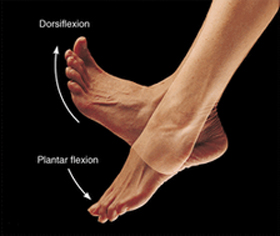The calf muscle group comprises of two muscles Gastrocnemius which has 2 large muscle bellies and the deep calf muscle called Soleus.
Ruptures of the calf commonly occur at the point where the Achilles tendon merges with one of the bellies of Gastrocnemius, occurring in sports such as badminton, tennis, squash, basketball, running and jumping sports. A sudden pain is felt in the calf, the injured athlete will have immediate difficulty in contracting the calf muscle and walking on tip toe, a gap can be felt in the muse over the injured area.
Immediate treatment should include ice, applying a compression bandage, elevate the leg and rest, and consult with a Physiotherapist. Should you not seek treatment, the untreated muscle rupture will will fill in with scar tissue which has reduced elasticity and will lead to repetitive injury.
Re-occurring calf strains are also an indicator of an underlying biomechanical problem.
Podiatrists are specialists in assessing and treating biomechanical problems.
Rupture of the Soleus muscle can occur during vigorous take-offs or jump-ups where this muscle is repetitvely overloaded.
Pain in soleus is usually felt deep down into the calf and is aggravated when the foot of the injured calf is bent down against resistance and when trying to walk on tiptoe, brusing can become visible on the inner side of the shin. Immediate treatment should include ice, applying a compression bandage, elevate the leg and rest, and consult with a Physiotherapist.
What is an Ankle Equinus?
Equinus is a condition in which the upward bending motion or dorsiflexion of the ankle joint is limited to less than 10 degrees of movement. 10 degrees of movement within the ankle joint is the minimum range of movement necessary for normal gait and without it, the function of the foot and its associated structures within the lower limb are severly affected. Someone with equinus lacks the flexibility to bring the top of the foot toward the front of the leg.
Equinus can occur in one or both feet. When it involves both feet, the limitation of motion is sometimes worse in one foot than in the other.
Those people with equinus develop ways to “compensate” for their limited ankle motion, and this often leads to other foot, leg, or back problems. The most common methods of compensation are flattening of the arch or lifting up the heel early when walking (premature heel lift) placing increased pressure on the ball of the foot. Those people with equinus develop ways to “compensate” for their limited ankle motion, and this often leads to other foot, leg, or back problems. The most common methods of compensation are flattening of the arch or lifting up the heel early when walking(premature heel lift) placing increased pressure on the ball of the foot.
Other people compensate by “toe walking,” while a smaller number take steps by bending abnormally at the hip or knee.
Causes
There are several possible causes for the limited range of ankle motion. Often it is due to tightness in the Achilles tendon or calf muscles (the soleus muscle and/or gastrocnemius muscle).
- In some patients, this tightness is congenital (present at birth) and some times it is an inherited trait.
- Tightness from being in a cast, being on crutches, or frequently wearing high-heeled shoes.
- A bone blocking the ankle motion eg a fragment of a broken bone following an ankle injury, or bone block, can get in the way and restrict motion.
- From one leg being shorter than the other.
- Spasms in the calf muscle. These spasms may be signs of an underlying neurological disorder.
Foot Problems Related to Equinus
Depending on how a patient compensates for the inability to bend properly at the ankle, a variety of foot conditions can develop, including:
- Plantar fasciitis (arch/heel pain)
- Calf cramping
- Tendonitis (inflammation in the Achilles tendon)
- Metatarsalgia (pain and/or callusing on the ball of the foot)
- Flatfoot
- Arthritis of the midfoot (middle area of the foot)
- Pressure sores on the ball of the foot or the arch
- Ankle pain
- Shin splints
Most patients we see with ankle equinus are unaware that they have this condition when they first visit, patients are usually seeking relief for foot problems associated with an equinus.
To diagnose equinus, Podiatrists will evaluate the ankle’s range of motion when the knee is flexed (bent) as well as extended (straightened). This enables the Podiatrist to identify whether the tendon or muscle is tight and to assess whether bone is interfering with ankle motion. X-rays may also be useful in identifying any underlying boney mechanical issue that may contribute to an equinus.
Non-Surgical Treatment
Treatment is aimed at relieving the symptoms and conditions associated with equinus. In addition, the patient is treated for the equinus itself through one or more of the following options:
Night splint
The foot may be placed in a splint at night to keep it in a position that helps reduce tightness of the calf muscle.
Heel lifts
Placing heel lifts inside the shoes or wearing shoes with a moderate heel takes stress off the Achilles tendon when walking and may reduce symptoms.
Orthotic devices
Custom orthotic devices that fit into the shoe are often prescribed to keep weight distributed properly and to help control muscle/tendon imbalance.
Ankle rehab
To help remedy muscle tightness, exercises that stretch the calf muscle(s) are recommended.
When is Surgery Needed?
In some cases, surgery may be needed to correct the cause of equinus if it is related to a tight tendon or a bone blocking the ankle motion.


